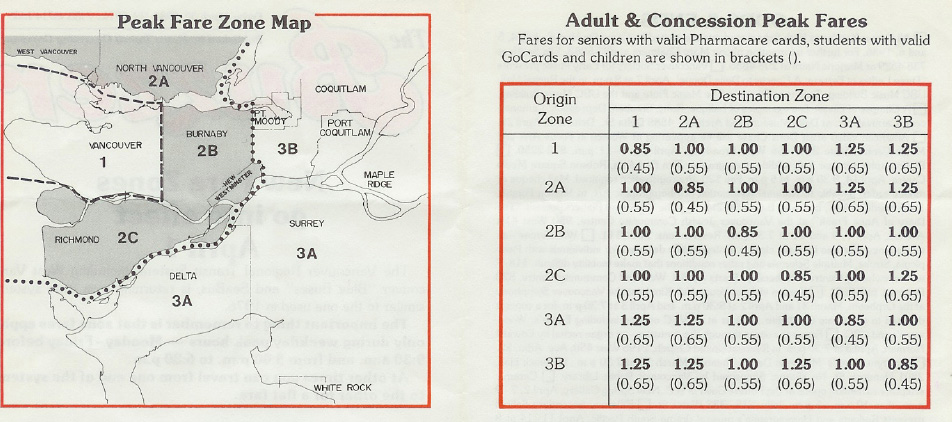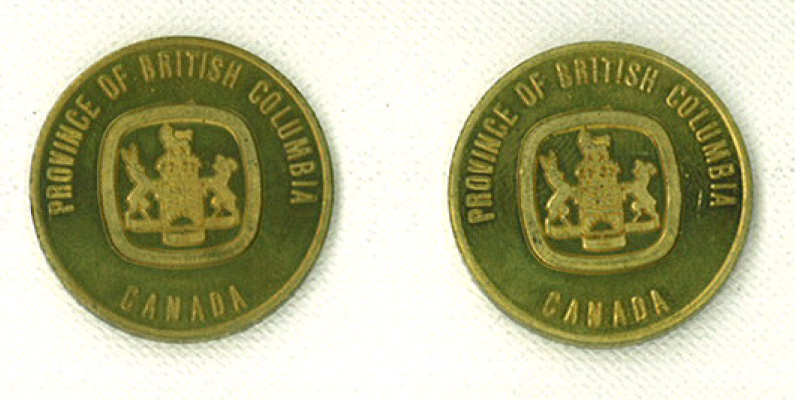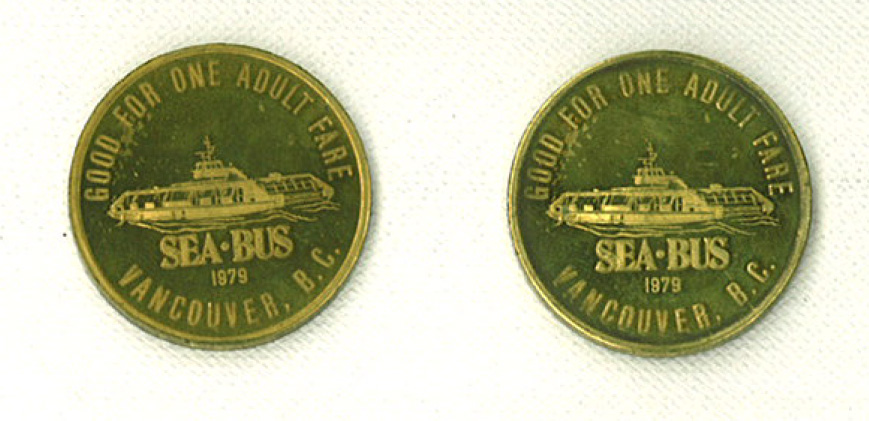Friday fun trivia: what the heck is this SeaBus token?
Friday fun trivia: what the heck is this SeaBus token?
If you like, skip to the end of this post to see an old-school SeaBus token and help figure out its story!
Results from last week: what years is this ticket from, part 2
OK, so last week I asked you to tell me what year this ticket was from.

Congrats to Reva who caught it right away, given the presence of a certain logo:
I’d say this is from 1990, given the Centennial Celebration logo watermark in the background. Ah, high school memories… :) I think I actually have one of these in my limited transfer collection.
Well done to Eric, Dennis, Kevin Ellis, and Chris Yee too for also pointing out the right year!
Yes, the Centennial Celebration logo is the right marker: in 1990, B.C. Transit celebrated 100 years of transit in Vancouver and Victoria. There were a number of celebrations and contests, including a special “Transit Centennial Centre” in Stadium SkyTrain Station. (Here’s the Centennial Centre pamphlet!)
As Reva also pointed out in the comments, special Buzzers with historical content were also produced in 1990. Here’s the ones I have on hand: January 12, February 23, March 23, and June 26.
Okay, now about the ticket itself: I had to talk to four or five people to just get the basic info on this ticket. Special thanks to Derek Cheung, Rob Chew, and John Wollenzin for their help!
Briefly though: in 1990, when you purchased a ticket, it was valid for 90 minutes in one direction only. The operator punched the centre columns for the route number (eg. #3 would punch 003) and then “E” or “W” depending which direction you were travelling.
Spec indicated a “special” bus, such as one assigned to pick up the crowds out of Exhibition Park. Grge was a bus headed for the garage. And Last Section… well, it was used when you were on a route that might let you get away with travelling in both directions. Derek Cheung explains it:
The “Last Section” was used to indicate that the transfer was issued on the latter half of the trip, meant for trolley routes travelling through downtown. In fact the boundary for issuing “Last Section” punched transfers was Homer Street.
Example: the 20 Granville/Victoria line was a U-shaped route which crossed 49th Avenue twice: at Victoria, and at Granville. I lived near 49th & Victoria, so I could conceivably board a northbound “20 Granville” on Victoria to head downtown (transfer issued would have been punched 020, E, Zone 1), do my business then board another “20 Granville” bus to 49th & Granville, then transfer to an eastbound #49 to get home, all on one transfer. The fact that this transfer wasn’t punched “Last Section” would indicate to the #49 operator that I did not originate my trip downtown and I was technically making a return trip.
Confused?

Rob Chew helped out with a zone map to identify how the zones used to work, too. Check out the picture at right. There were basically 6 zones and 36 different possibilities for zone origin and destination! And you thought our current system was complicated….
This week: what the heck is this SeaBus token?
OK, this one is genuinely a “What on earth is this?” question. I’ve dug up some SeaBus tokens from 1979 — can anyone remember how they were used way back when?


It’s about the size of a quarter in real life. Click both photos for larger versions. Let me know if you have any ideas, and I’ll see what I can dig up on these tokens by next week!






From what i was told by my folks tokens were used in order to get the turnstiles to move. Also the original color was orange. But i think that it was kinda like how tokens were used as a means of fare on the NYC subway and how its still used in the TTC system. Now correct me if I’m wrong but someone once told me that when we switched to the electronic fareboxes in 2001 some of them were spares from the NYC system. BTW if its a double post just delete the first one or whichever sounds a lot better, cause my computer has been acting up all day.
Ed note: Bryan, I deleted the first post! All is well.
The original SeaBus fare machines were essentially a photocopier: the printed ticket was a cash register-sized length of paper with an image of all the coins that you had deposited.
If you paid your fare in pennies, it would a a HUGE length of paper showing all 75 (or whatever the fare was) pennies!
@ Derek Cheung: That has got to be the most bizarre ticket-printing method I think I have ever heard!
I remember riding on the SeaBus when it was still orange, but I was very young so unfortunately I have no memory of how those tokens were used. Great esoteric bit of Vancouver transit memorabilia, Jhenifer!
Apparently these were the first ticket machines ever used in the Metro Vancouver transit system.
I want to follow up on Reva’s comment – yes, the SeaBus was orange, and here’s what an in-bus advert for it looked like:
http://www.flickr.com/photos/rickie22/1794552363/
Very cool! I found a picture of the Sea Bus when it was painted International Orange (like the Golden Gate Bridge). Jhenifer probably has better photos though. Is this photo from someone that follows this blog?
http://members.shaw.ca/dave_too2/bus/Seabus.jpg
I think the ticket machine would photocopy the SeaBus token.
Was it 1990 or 1986 when BC Transit produced a set of commemorative tokens? Each token pictured a different mode of transit.
With these tokens the SkyTrain TVM’s would accept them as one adult fare.
I’ve got a set kicking around somewhere…
That was 1986 Derek. For the opening of SkyTrain, (Rapid Transit, as it was not branded yet)
There were 5 coins, and if you wanted they were worth $1 toward the fare.
There were two coins each with a different image of the SkyTrain, a coin with the SeaBus, one with a E900 trolley, and a coin with a profile of a HandiDart.
The slogan on the bottom of the commemorative holder was “Catch The Spirit”.
On the other side, was various information on BC Transit’s then 50 conventional and custom transit operations in BC.
Darn, the link broke along the way… it works if you cut and paste, also here’s the same poster from Rickie22’s set
http://www.flickr.com/photos/rickie22/1795386896/sizes/l/in/set-72157602594969846/
@Derek, I once purchased a Seabus ticket with all nickels, the ticket was as long as my arm… I don’t think the machine accepted pennies, but I could be wrong. I probably still have that ticket buried in the basement, along with some BC Hydro-era transfers, with the letter instead of the date.
@Shane and @Eric, the flickr set is very similar to mine, must have been taken on the same bus… This is one of my favourites, from the 80s most likely
http://members.shaw.ca/dave_too2/bus/P1000640%20(2).JPG
Today they’d have to add “Phone No Evil” to the list
@ Dave 2: I would *love* to see the old BC Hydro transfers & that SeaBus ticket you have… any chance of uploading scans of them to Flickr or someplace? It’ll be raining all week, perfect time to go through the stuff in your basement, lol! (I keed.) Seriously though, most websites with pictures of vintage Vancouver transit system tickets have pieces dating from the streetcar era, or from the late-80s to present, and nothing from in between. Anyone know of a good source for imagery of late-50s through early 80s Vancouver transit tickets, maps, memorabilia, etc? I know it’s a bit of an obscure request. Derek? Bryan? Jhenifer? Many thanks in advance. :)
@Reva, no luck on the transfers, though I did find a lot of Buzzers, Brochures, and newspaper articles from the building and opening of the Skytrain Line circa 1982-1986. Perhaps I’ll will them to the Buzzer Blog ;)
Dave2: The Buzzer blog would be happy to be bequeathed with such archival transit splendor :)
my friend has a plastic package from 1986 which has catch the spirit[the opening of sky train] on it. inside are tokens to use for transit. are these of any interest or value?please let me know, thank you!
Shirle:
That’s a commemorative package from the opening of SkyTrain. I think you’d have to inquire with collectors to know what the value is: I hadn’t heard offhand that it was worth a lot though. Though the sentimental value, of course, is priceless :) We do have a number of those sets in the office, so I don’t think we would need them here.
[…] Many moons ago, Eric shared this photo of a vintage SeaBus ad in a historic Brill trolley. Can you believe the SeaBus used to be orange back in the 1970s? […]
[…] of the 1970s and how it worked, exactly? A few kind folks have provided a nice explanation of the 1990s transfer system in the past—is it […]
I appreciate the explanation for the old transfers. I only finished reading about it now, even though I have wondered for years, what the numbers and stuff meant.
I often kept my transfers to be used as bookmarks.
I remember when I went from Richmond to New Westminster [or was it the other way around??], in the late 90s, the bus driver actually wanted to charge me for riding 2 zones. That really upset me, because I thought of it as only 1 zone, called Zone 2. Now that I know about Zone 2A, etc., I can be a bit more sympathetic about it. Maybe he was not brought up to speed. Maybe I misunderstood. Maybe the company did not explain it well. Whatever.
Could somebody confirm whether we can travel from Richmond to New Westminster, and vice versa, on a 1 zone fare, during the weekday? I strongly believe that that is the case, but I also kind of wonder if there is an unknown rule that the majority of people [transit fanatics included] do not know about.
Eugene: I asked our FareDealer department and here’s what they’ve told me.
Thanks, Jhenifer.
Burt the Bus Driver here
In response to Eugene.
I do know for a fact that from my weekly commute from Burnaby/New West into Richmond, you can embark on the 410 Railway from 22nd Street Stn into Richmond (via Queensborough) as a single zone fare.
And yes it’s the only ‘loophole’ in the zone system that we know of.
Extra FYIs
There are 3 distinct zone ‘buffer’ areas that run on a zone boundary
-C1 Kootenay Loop/Hastings @ Gilmore (runs along Boundary)
-28 Joyce Stn/Phibbs Exch
-97 B-Line Coq Stn/Lougheed
Riders do be aware if a zone boundary is crossed, one must have proper fare!
Thanks for riding folks!
@Burt
Thanks for the confirmation.
Do you have any video of that? I’d like to find out some additional information.
Hi,
I always like taking the Sea-Bus and enjoying the view.
I’d like to know why the name Sea-Bus was de-hyphenated and when this change occurred. And note that your caption under the pictures of the token says SeaBus but the tokens actually say, Sea-Bus.
-Tony
Pretty sure it was at the same time as the new rapid transit was branded SkyTrain. I worked for the design company involved with the branding, station and train graphics, maps, ticket machine graphics, and the commemorative tokens. What a fun project! The original SkyTrain ticket machines were purchased used, from Australia if I remember correctly.